Psychology Test: Normality and Abnormality, Classification of Mental Disorders, Models of Atypical Behavior and Treatment Options
VerifiedAdded on 2023/06/15
|9
|2309
|480
AI Summary
This psychology test covers topics such as normality and abnormality, classification of mental disorders, models of atypical behavior and treatment options. It discusses the concept of normality and abnormality, the main systems for classification of mental disorders, evaluation of models of atypical behavior, and different treatment options according to different models. The article also includes references to support the discussion.
Contribute Materials
Your contribution can guide someone’s learning journey. Share your
documents today.

Running head: PSYCHOLOGY TEST
Psychology test
Name of the student:
Name of the University:
Author’s note
Psychology test
Name of the student:
Name of the University:
Author’s note
Secure Best Marks with AI Grader
Need help grading? Try our AI Grader for instant feedback on your assignments.
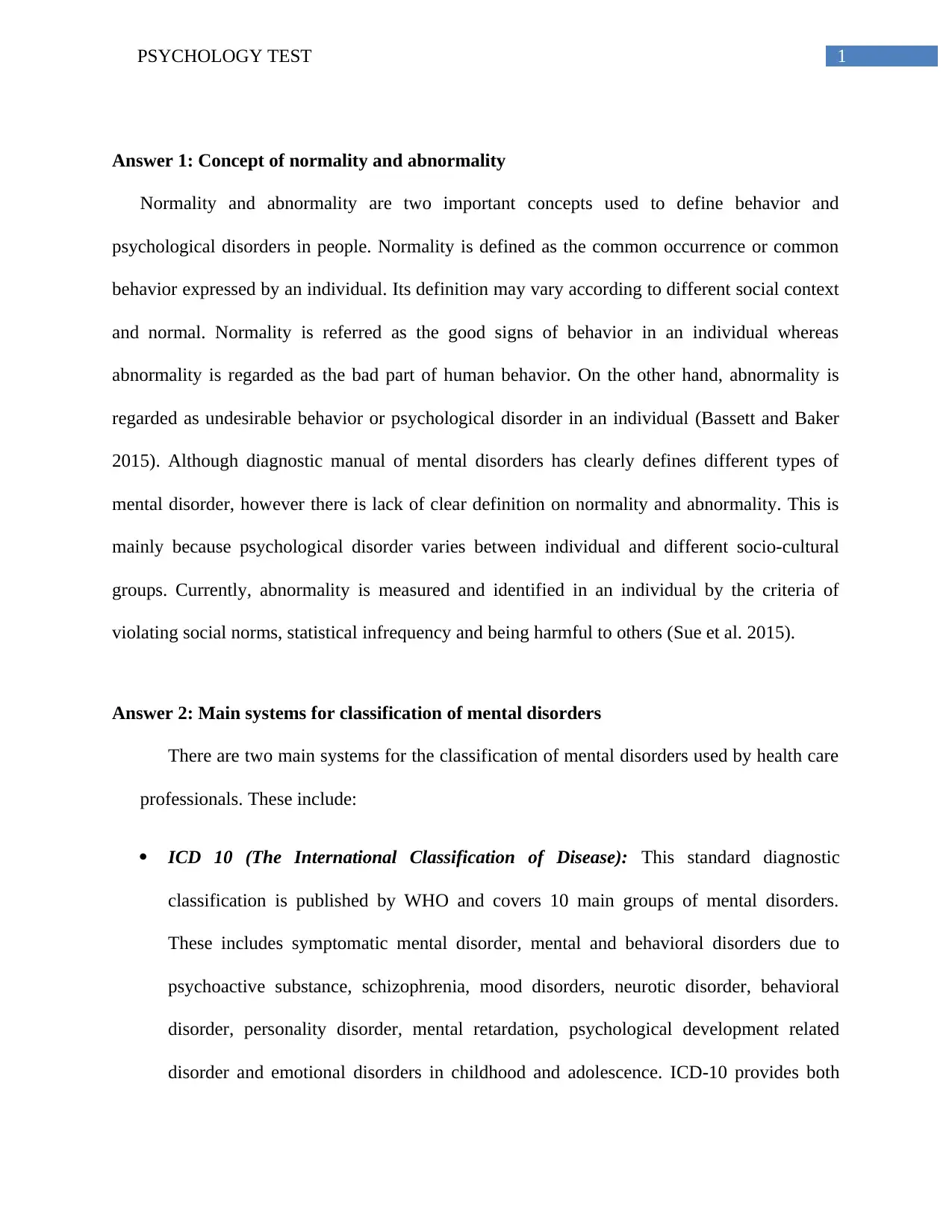
1PSYCHOLOGY TEST
Answer 1: Concept of normality and abnormality
Normality and abnormality are two important concepts used to define behavior and
psychological disorders in people. Normality is defined as the common occurrence or common
behavior expressed by an individual. Its definition may vary according to different social context
and normal. Normality is referred as the good signs of behavior in an individual whereas
abnormality is regarded as the bad part of human behavior. On the other hand, abnormality is
regarded as undesirable behavior or psychological disorder in an individual (Bassett and Baker
2015). Although diagnostic manual of mental disorders has clearly defines different types of
mental disorder, however there is lack of clear definition on normality and abnormality. This is
mainly because psychological disorder varies between individual and different socio-cultural
groups. Currently, abnormality is measured and identified in an individual by the criteria of
violating social norms, statistical infrequency and being harmful to others (Sue et al. 2015).
Answer 2: Main systems for classification of mental disorders
There are two main systems for the classification of mental disorders used by health care
professionals. These include:
ICD 10 (The International Classification of Disease): This standard diagnostic
classification is published by WHO and covers 10 main groups of mental disorders.
These includes symptomatic mental disorder, mental and behavioral disorders due to
psychoactive substance, schizophrenia, mood disorders, neurotic disorder, behavioral
disorder, personality disorder, mental retardation, psychological development related
disorder and emotional disorders in childhood and adolescence. ICD-10 provides both
Answer 1: Concept of normality and abnormality
Normality and abnormality are two important concepts used to define behavior and
psychological disorders in people. Normality is defined as the common occurrence or common
behavior expressed by an individual. Its definition may vary according to different social context
and normal. Normality is referred as the good signs of behavior in an individual whereas
abnormality is regarded as the bad part of human behavior. On the other hand, abnormality is
regarded as undesirable behavior or psychological disorder in an individual (Bassett and Baker
2015). Although diagnostic manual of mental disorders has clearly defines different types of
mental disorder, however there is lack of clear definition on normality and abnormality. This is
mainly because psychological disorder varies between individual and different socio-cultural
groups. Currently, abnormality is measured and identified in an individual by the criteria of
violating social norms, statistical infrequency and being harmful to others (Sue et al. 2015).
Answer 2: Main systems for classification of mental disorders
There are two main systems for the classification of mental disorders used by health care
professionals. These include:
ICD 10 (The International Classification of Disease): This standard diagnostic
classification is published by WHO and covers 10 main groups of mental disorders.
These includes symptomatic mental disorder, mental and behavioral disorders due to
psychoactive substance, schizophrenia, mood disorders, neurotic disorder, behavioral
disorder, personality disorder, mental retardation, psychological development related
disorder and emotional disorders in childhood and adolescence. ICD-10 provides both

2PSYCHOLOGY TEST
clinical description as well as diagnostic guidelines to health care professionals (WHO |
ICD-10 classification of mental and behavioral disorders 2017). DSM-IV (Diagnostic and Statistical Manual of Mental Disorder): The DSM-IV manual
is published by the American Psychiatric Association and it classified and defines all
types of mental disorders found in both adults and children. By the use of DSM-IV
manual, health care professional can use multidimensional approach to diagnose mental
illness. The advantage of this manual is that it allows health care professionals to provide
a comprehensive diagnosis of mental illness defined by considering all factors that
contribute to illness (Proctor, Kopa and Hoffmann 2014). They mainly assess the
following five dimensions to confirm the type of mental illness in patient:
Axis I: It is the top level in the multi-axial system of diagnosis which gives idea about acute
symptoms that can be treated. For example, major depressive episode, schizophrenia and panic
attack are most familiar symptoms.
Axis II: This dimension helps in the assessment of developmental and personality disorders.
Some example of developmental disorders includes autism and one example of personality
disorders include paranoid and borderline personality disorder. These are life long mental
problem that starts from childhood. Diagnosis of such disorder is also associated with social
stigma as it such patients face challenges in adapting to demands of the society (Tyrer et al.
2015).
Axis III: This dimension focus on assessment of physical conditions that can help in determining
the cause of disorder mentioned in axis I and II.
clinical description as well as diagnostic guidelines to health care professionals (WHO |
ICD-10 classification of mental and behavioral disorders 2017). DSM-IV (Diagnostic and Statistical Manual of Mental Disorder): The DSM-IV manual
is published by the American Psychiatric Association and it classified and defines all
types of mental disorders found in both adults and children. By the use of DSM-IV
manual, health care professional can use multidimensional approach to diagnose mental
illness. The advantage of this manual is that it allows health care professionals to provide
a comprehensive diagnosis of mental illness defined by considering all factors that
contribute to illness (Proctor, Kopa and Hoffmann 2014). They mainly assess the
following five dimensions to confirm the type of mental illness in patient:
Axis I: It is the top level in the multi-axial system of diagnosis which gives idea about acute
symptoms that can be treated. For example, major depressive episode, schizophrenia and panic
attack are most familiar symptoms.
Axis II: This dimension helps in the assessment of developmental and personality disorders.
Some example of developmental disorders includes autism and one example of personality
disorders include paranoid and borderline personality disorder. These are life long mental
problem that starts from childhood. Diagnosis of such disorder is also associated with social
stigma as it such patients face challenges in adapting to demands of the society (Tyrer et al.
2015).
Axis III: This dimension focus on assessment of physical conditions that can help in determining
the cause of disorder mentioned in axis I and II.
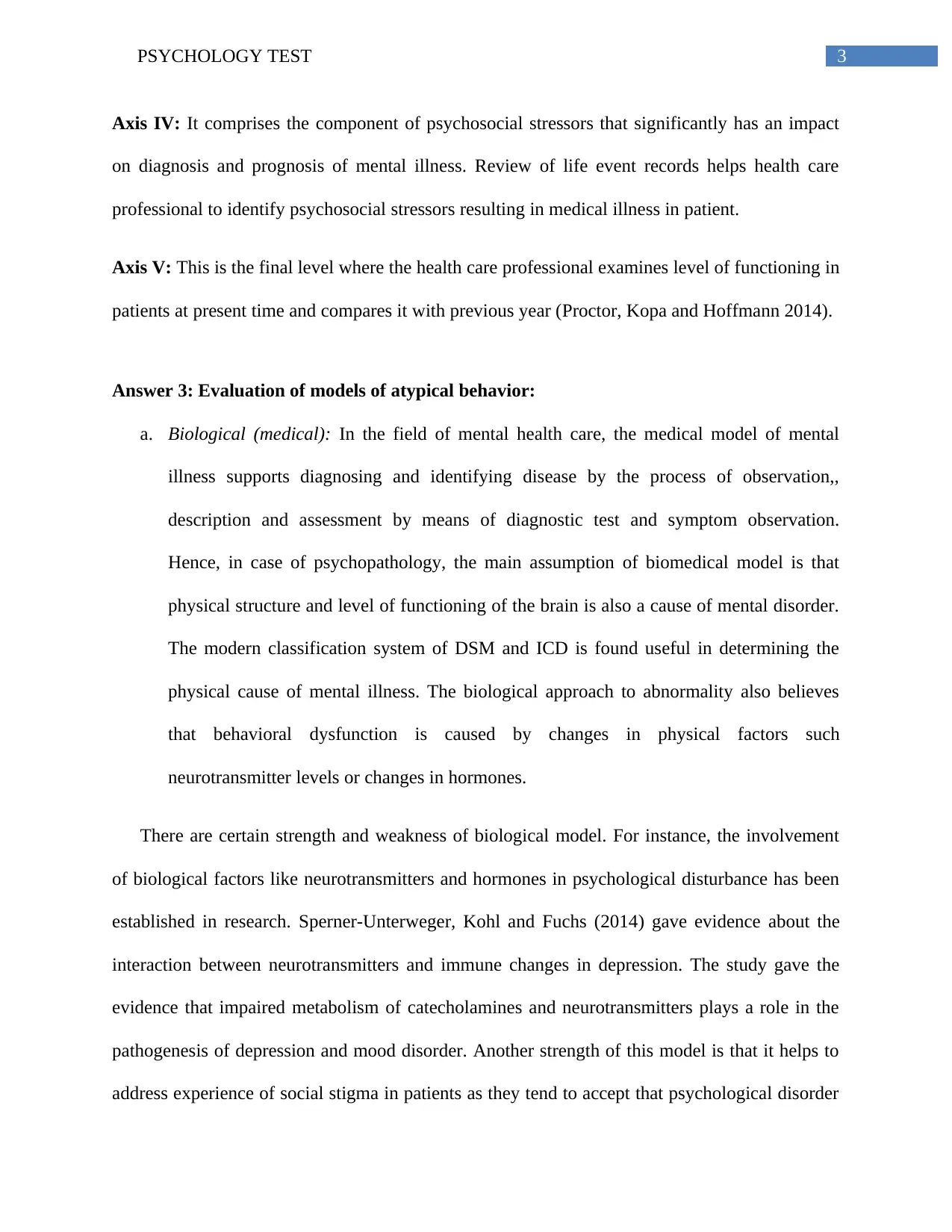
3PSYCHOLOGY TEST
Axis IV: It comprises the component of psychosocial stressors that significantly has an impact
on diagnosis and prognosis of mental illness. Review of life event records helps health care
professional to identify psychosocial stressors resulting in medical illness in patient.
Axis V: This is the final level where the health care professional examines level of functioning in
patients at present time and compares it with previous year (Proctor, Kopa and Hoffmann 2014).
Answer 3: Evaluation of models of atypical behavior:
a. Biological (medical): In the field of mental health care, the medical model of mental
illness supports diagnosing and identifying disease by the process of observation,,
description and assessment by means of diagnostic test and symptom observation.
Hence, in case of psychopathology, the main assumption of biomedical model is that
physical structure and level of functioning of the brain is also a cause of mental disorder.
The modern classification system of DSM and ICD is found useful in determining the
physical cause of mental illness. The biological approach to abnormality also believes
that behavioral dysfunction is caused by changes in physical factors such
neurotransmitter levels or changes in hormones.
There are certain strength and weakness of biological model. For instance, the involvement
of biological factors like neurotransmitters and hormones in psychological disturbance has been
established in research. Sperner-Unterweger, Kohl and Fuchs (2014) gave evidence about the
interaction between neurotransmitters and immune changes in depression. The study gave the
evidence that impaired metabolism of catecholamines and neurotransmitters plays a role in the
pathogenesis of depression and mood disorder. Another strength of this model is that it helps to
address experience of social stigma in patients as they tend to accept that psychological disorder
Axis IV: It comprises the component of psychosocial stressors that significantly has an impact
on diagnosis and prognosis of mental illness. Review of life event records helps health care
professional to identify psychosocial stressors resulting in medical illness in patient.
Axis V: This is the final level where the health care professional examines level of functioning in
patients at present time and compares it with previous year (Proctor, Kopa and Hoffmann 2014).
Answer 3: Evaluation of models of atypical behavior:
a. Biological (medical): In the field of mental health care, the medical model of mental
illness supports diagnosing and identifying disease by the process of observation,,
description and assessment by means of diagnostic test and symptom observation.
Hence, in case of psychopathology, the main assumption of biomedical model is that
physical structure and level of functioning of the brain is also a cause of mental disorder.
The modern classification system of DSM and ICD is found useful in determining the
physical cause of mental illness. The biological approach to abnormality also believes
that behavioral dysfunction is caused by changes in physical factors such
neurotransmitter levels or changes in hormones.
There are certain strength and weakness of biological model. For instance, the involvement
of biological factors like neurotransmitters and hormones in psychological disturbance has been
established in research. Sperner-Unterweger, Kohl and Fuchs (2014) gave evidence about the
interaction between neurotransmitters and immune changes in depression. The study gave the
evidence that impaired metabolism of catecholamines and neurotransmitters plays a role in the
pathogenesis of depression and mood disorder. Another strength of this model is that it helps to
address experience of social stigma in patients as they tend to accept that psychological disorder
Paraphrase This Document
Need a fresh take? Get an instant paraphrase of this document with our AI Paraphraser
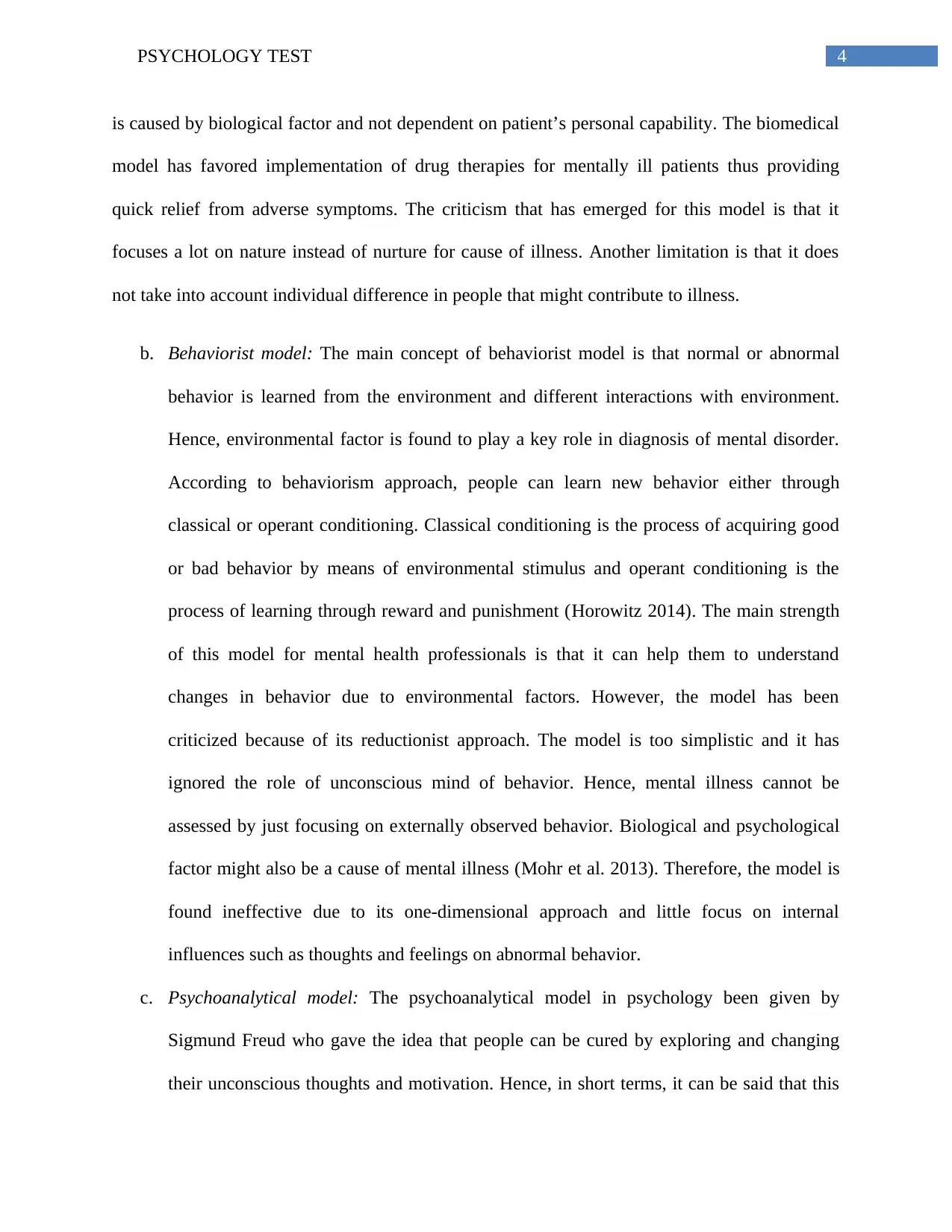
4PSYCHOLOGY TEST
is caused by biological factor and not dependent on patient’s personal capability. The biomedical
model has favored implementation of drug therapies for mentally ill patients thus providing
quick relief from adverse symptoms. The criticism that has emerged for this model is that it
focuses a lot on nature instead of nurture for cause of illness. Another limitation is that it does
not take into account individual difference in people that might contribute to illness.
b. Behaviorist model: The main concept of behaviorist model is that normal or abnormal
behavior is learned from the environment and different interactions with environment.
Hence, environmental factor is found to play a key role in diagnosis of mental disorder.
According to behaviorism approach, people can learn new behavior either through
classical or operant conditioning. Classical conditioning is the process of acquiring good
or bad behavior by means of environmental stimulus and operant conditioning is the
process of learning through reward and punishment (Horowitz 2014). The main strength
of this model for mental health professionals is that it can help them to understand
changes in behavior due to environmental factors. However, the model has been
criticized because of its reductionist approach. The model is too simplistic and it has
ignored the role of unconscious mind of behavior. Hence, mental illness cannot be
assessed by just focusing on externally observed behavior. Biological and psychological
factor might also be a cause of mental illness (Mohr et al. 2013). Therefore, the model is
found ineffective due to its one-dimensional approach and little focus on internal
influences such as thoughts and feelings on abnormal behavior.
c. Psychoanalytical model: The psychoanalytical model in psychology been given by
Sigmund Freud who gave the idea that people can be cured by exploring and changing
their unconscious thoughts and motivation. Hence, in short terms, it can be said that this
is caused by biological factor and not dependent on patient’s personal capability. The biomedical
model has favored implementation of drug therapies for mentally ill patients thus providing
quick relief from adverse symptoms. The criticism that has emerged for this model is that it
focuses a lot on nature instead of nurture for cause of illness. Another limitation is that it does
not take into account individual difference in people that might contribute to illness.
b. Behaviorist model: The main concept of behaviorist model is that normal or abnormal
behavior is learned from the environment and different interactions with environment.
Hence, environmental factor is found to play a key role in diagnosis of mental disorder.
According to behaviorism approach, people can learn new behavior either through
classical or operant conditioning. Classical conditioning is the process of acquiring good
or bad behavior by means of environmental stimulus and operant conditioning is the
process of learning through reward and punishment (Horowitz 2014). The main strength
of this model for mental health professionals is that it can help them to understand
changes in behavior due to environmental factors. However, the model has been
criticized because of its reductionist approach. The model is too simplistic and it has
ignored the role of unconscious mind of behavior. Hence, mental illness cannot be
assessed by just focusing on externally observed behavior. Biological and psychological
factor might also be a cause of mental illness (Mohr et al. 2013). Therefore, the model is
found ineffective due to its one-dimensional approach and little focus on internal
influences such as thoughts and feelings on abnormal behavior.
c. Psychoanalytical model: The psychoanalytical model in psychology been given by
Sigmund Freud who gave the idea that people can be cured by exploring and changing
their unconscious thoughts and motivation. Hence, in short terms, it can be said that this
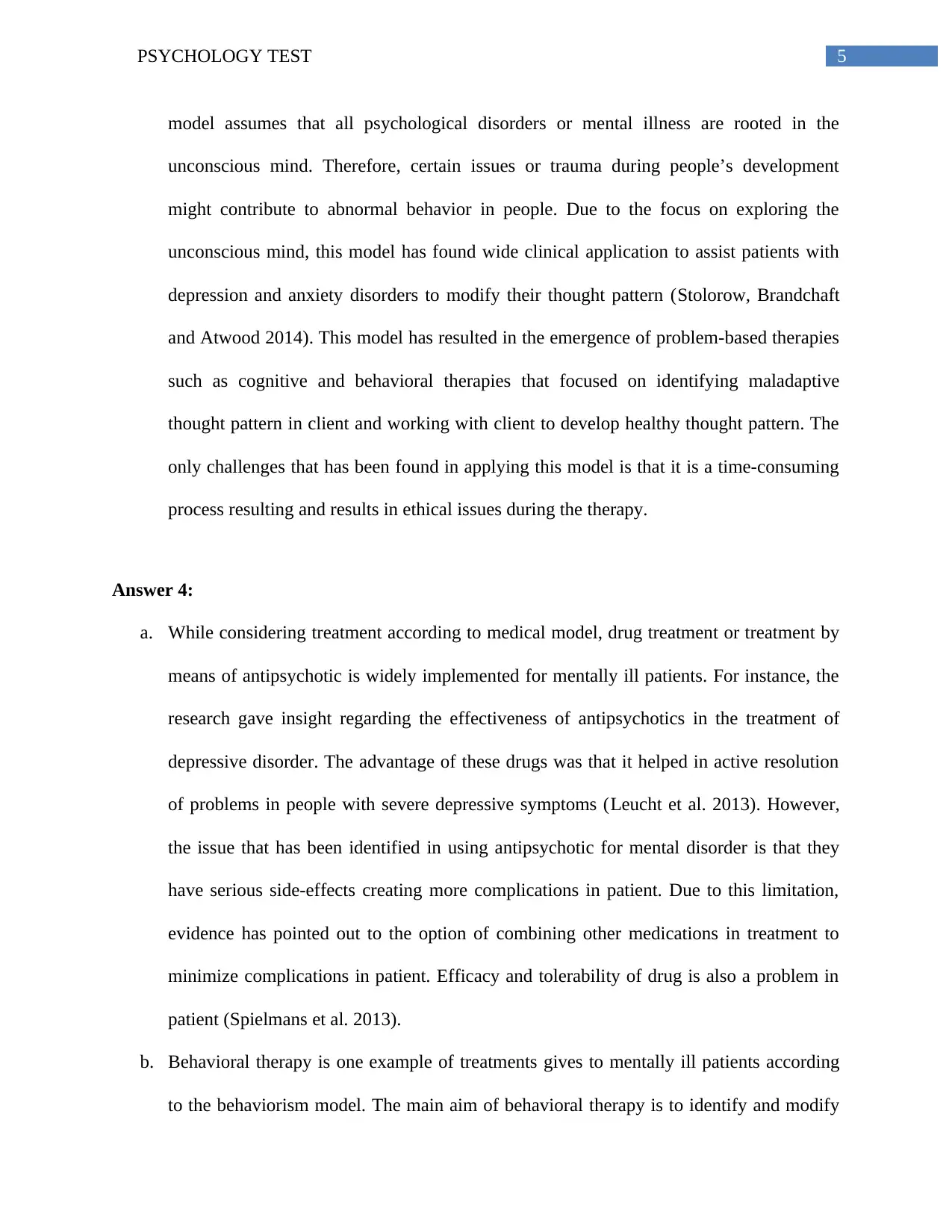
5PSYCHOLOGY TEST
model assumes that all psychological disorders or mental illness are rooted in the
unconscious mind. Therefore, certain issues or trauma during people’s development
might contribute to abnormal behavior in people. Due to the focus on exploring the
unconscious mind, this model has found wide clinical application to assist patients with
depression and anxiety disorders to modify their thought pattern (Stolorow, Brandchaft
and Atwood 2014). This model has resulted in the emergence of problem-based therapies
such as cognitive and behavioral therapies that focused on identifying maladaptive
thought pattern in client and working with client to develop healthy thought pattern. The
only challenges that has been found in applying this model is that it is a time-consuming
process resulting and results in ethical issues during the therapy.
Answer 4:
a. While considering treatment according to medical model, drug treatment or treatment by
means of antipsychotic is widely implemented for mentally ill patients. For instance, the
research gave insight regarding the effectiveness of antipsychotics in the treatment of
depressive disorder. The advantage of these drugs was that it helped in active resolution
of problems in people with severe depressive symptoms (Leucht et al. 2013). However,
the issue that has been identified in using antipsychotic for mental disorder is that they
have serious side-effects creating more complications in patient. Due to this limitation,
evidence has pointed out to the option of combining other medications in treatment to
minimize complications in patient. Efficacy and tolerability of drug is also a problem in
patient (Spielmans et al. 2013).
b. Behavioral therapy is one example of treatments gives to mentally ill patients according
to the behaviorism model. The main aim of behavioral therapy is to identify and modify
model assumes that all psychological disorders or mental illness are rooted in the
unconscious mind. Therefore, certain issues or trauma during people’s development
might contribute to abnormal behavior in people. Due to the focus on exploring the
unconscious mind, this model has found wide clinical application to assist patients with
depression and anxiety disorders to modify their thought pattern (Stolorow, Brandchaft
and Atwood 2014). This model has resulted in the emergence of problem-based therapies
such as cognitive and behavioral therapies that focused on identifying maladaptive
thought pattern in client and working with client to develop healthy thought pattern. The
only challenges that has been found in applying this model is that it is a time-consuming
process resulting and results in ethical issues during the therapy.
Answer 4:
a. While considering treatment according to medical model, drug treatment or treatment by
means of antipsychotic is widely implemented for mentally ill patients. For instance, the
research gave insight regarding the effectiveness of antipsychotics in the treatment of
depressive disorder. The advantage of these drugs was that it helped in active resolution
of problems in people with severe depressive symptoms (Leucht et al. 2013). However,
the issue that has been identified in using antipsychotic for mental disorder is that they
have serious side-effects creating more complications in patient. Due to this limitation,
evidence has pointed out to the option of combining other medications in treatment to
minimize complications in patient. Efficacy and tolerability of drug is also a problem in
patient (Spielmans et al. 2013).
b. Behavioral therapy is one example of treatments gives to mentally ill patients according
to the behaviorism model. The main aim of behavioral therapy is to identify and modify
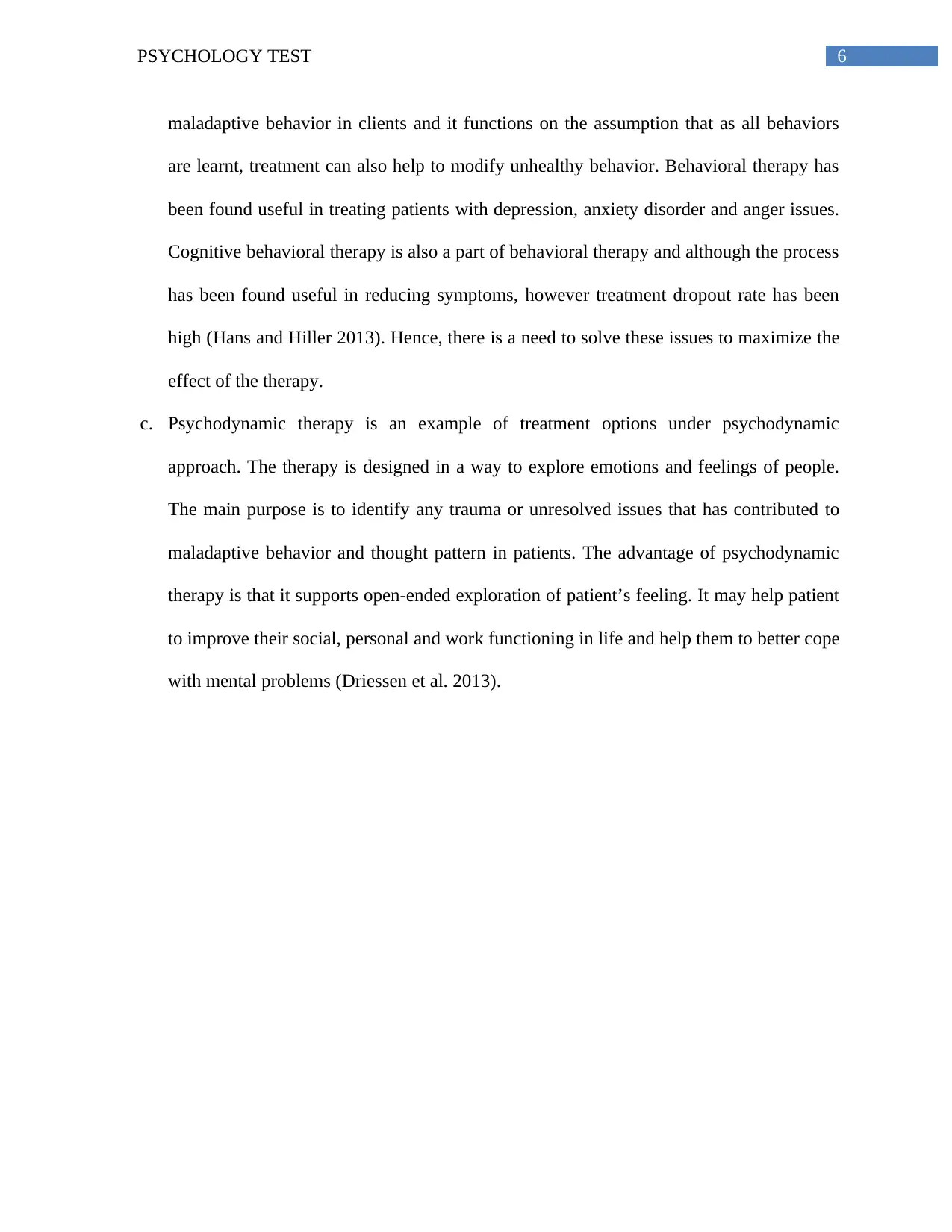
6PSYCHOLOGY TEST
maladaptive behavior in clients and it functions on the assumption that as all behaviors
are learnt, treatment can also help to modify unhealthy behavior. Behavioral therapy has
been found useful in treating patients with depression, anxiety disorder and anger issues.
Cognitive behavioral therapy is also a part of behavioral therapy and although the process
has been found useful in reducing symptoms, however treatment dropout rate has been
high (Hans and Hiller 2013). Hence, there is a need to solve these issues to maximize the
effect of the therapy.
c. Psychodynamic therapy is an example of treatment options under psychodynamic
approach. The therapy is designed in a way to explore emotions and feelings of people.
The main purpose is to identify any trauma or unresolved issues that has contributed to
maladaptive behavior and thought pattern in patients. The advantage of psychodynamic
therapy is that it supports open-ended exploration of patient’s feeling. It may help patient
to improve their social, personal and work functioning in life and help them to better cope
with mental problems (Driessen et al. 2013).
maladaptive behavior in clients and it functions on the assumption that as all behaviors
are learnt, treatment can also help to modify unhealthy behavior. Behavioral therapy has
been found useful in treating patients with depression, anxiety disorder and anger issues.
Cognitive behavioral therapy is also a part of behavioral therapy and although the process
has been found useful in reducing symptoms, however treatment dropout rate has been
high (Hans and Hiller 2013). Hence, there is a need to solve these issues to maximize the
effect of the therapy.
c. Psychodynamic therapy is an example of treatment options under psychodynamic
approach. The therapy is designed in a way to explore emotions and feelings of people.
The main purpose is to identify any trauma or unresolved issues that has contributed to
maladaptive behavior and thought pattern in patients. The advantage of psychodynamic
therapy is that it supports open-ended exploration of patient’s feeling. It may help patient
to improve their social, personal and work functioning in life and help them to better cope
with mental problems (Driessen et al. 2013).
Secure Best Marks with AI Grader
Need help grading? Try our AI Grader for instant feedback on your assignments.
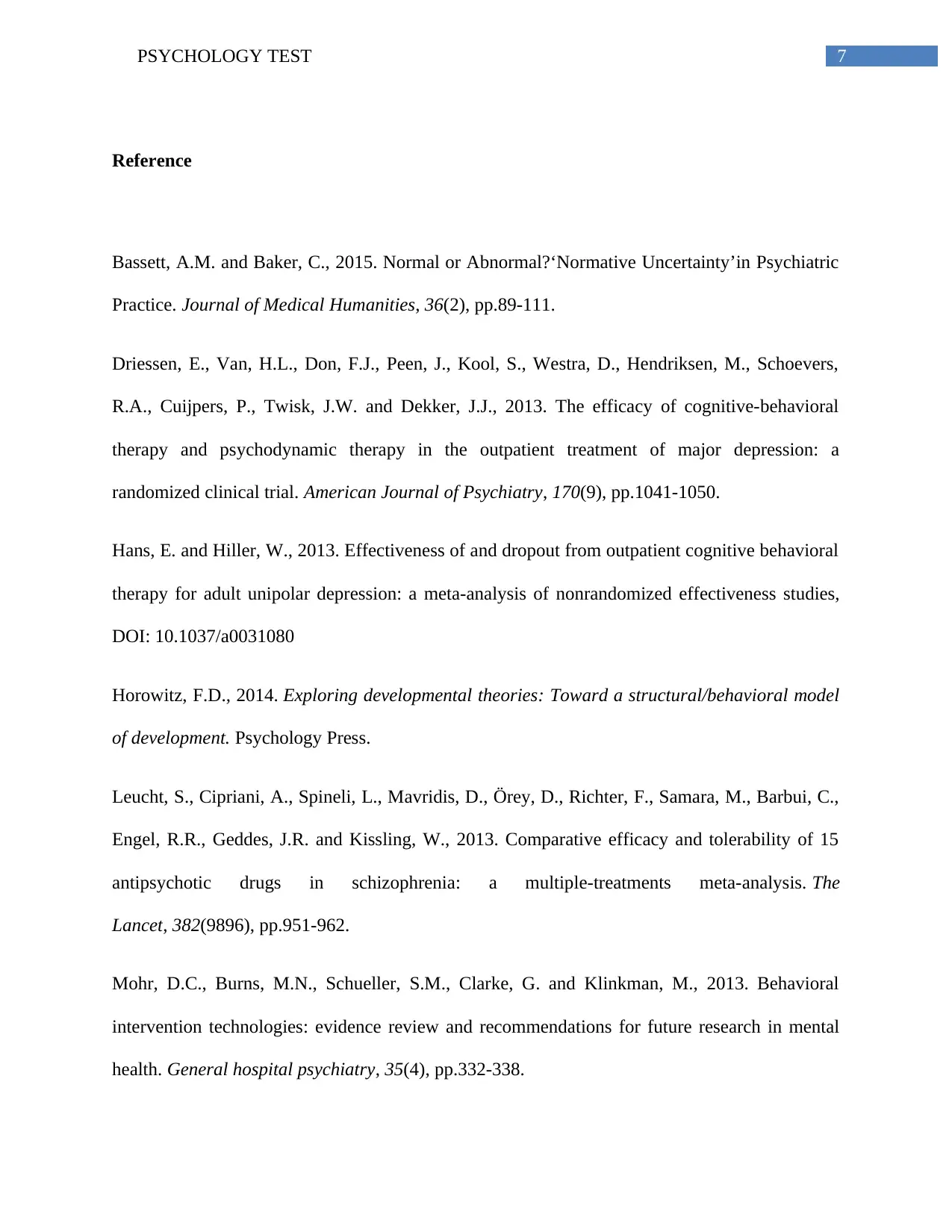
7PSYCHOLOGY TEST
Reference
Bassett, A.M. and Baker, C., 2015. Normal or Abnormal?‘Normative Uncertainty’in Psychiatric
Practice. Journal of Medical Humanities, 36(2), pp.89-111.
Driessen, E., Van, H.L., Don, F.J., Peen, J., Kool, S., Westra, D., Hendriksen, M., Schoevers,
R.A., Cuijpers, P., Twisk, J.W. and Dekker, J.J., 2013. The efficacy of cognitive-behavioral
therapy and psychodynamic therapy in the outpatient treatment of major depression: a
randomized clinical trial. American Journal of Psychiatry, 170(9), pp.1041-1050.
Hans, E. and Hiller, W., 2013. Effectiveness of and dropout from outpatient cognitive behavioral
therapy for adult unipolar depression: a meta-analysis of nonrandomized effectiveness studies,
DOI: 10.1037/a0031080
Horowitz, F.D., 2014. Exploring developmental theories: Toward a structural/behavioral model
of development. Psychology Press.
Leucht, S., Cipriani, A., Spineli, L., Mavridis, D., Örey, D., Richter, F., Samara, M., Barbui, C.,
Engel, R.R., Geddes, J.R. and Kissling, W., 2013. Comparative efficacy and tolerability of 15
antipsychotic drugs in schizophrenia: a multiple-treatments meta-analysis. The
Lancet, 382(9896), pp.951-962.
Mohr, D.C., Burns, M.N., Schueller, S.M., Clarke, G. and Klinkman, M., 2013. Behavioral
intervention technologies: evidence review and recommendations for future research in mental
health. General hospital psychiatry, 35(4), pp.332-338.
Reference
Bassett, A.M. and Baker, C., 2015. Normal or Abnormal?‘Normative Uncertainty’in Psychiatric
Practice. Journal of Medical Humanities, 36(2), pp.89-111.
Driessen, E., Van, H.L., Don, F.J., Peen, J., Kool, S., Westra, D., Hendriksen, M., Schoevers,
R.A., Cuijpers, P., Twisk, J.W. and Dekker, J.J., 2013. The efficacy of cognitive-behavioral
therapy and psychodynamic therapy in the outpatient treatment of major depression: a
randomized clinical trial. American Journal of Psychiatry, 170(9), pp.1041-1050.
Hans, E. and Hiller, W., 2013. Effectiveness of and dropout from outpatient cognitive behavioral
therapy for adult unipolar depression: a meta-analysis of nonrandomized effectiveness studies,
DOI: 10.1037/a0031080
Horowitz, F.D., 2014. Exploring developmental theories: Toward a structural/behavioral model
of development. Psychology Press.
Leucht, S., Cipriani, A., Spineli, L., Mavridis, D., Örey, D., Richter, F., Samara, M., Barbui, C.,
Engel, R.R., Geddes, J.R. and Kissling, W., 2013. Comparative efficacy and tolerability of 15
antipsychotic drugs in schizophrenia: a multiple-treatments meta-analysis. The
Lancet, 382(9896), pp.951-962.
Mohr, D.C., Burns, M.N., Schueller, S.M., Clarke, G. and Klinkman, M., 2013. Behavioral
intervention technologies: evidence review and recommendations for future research in mental
health. General hospital psychiatry, 35(4), pp.332-338.
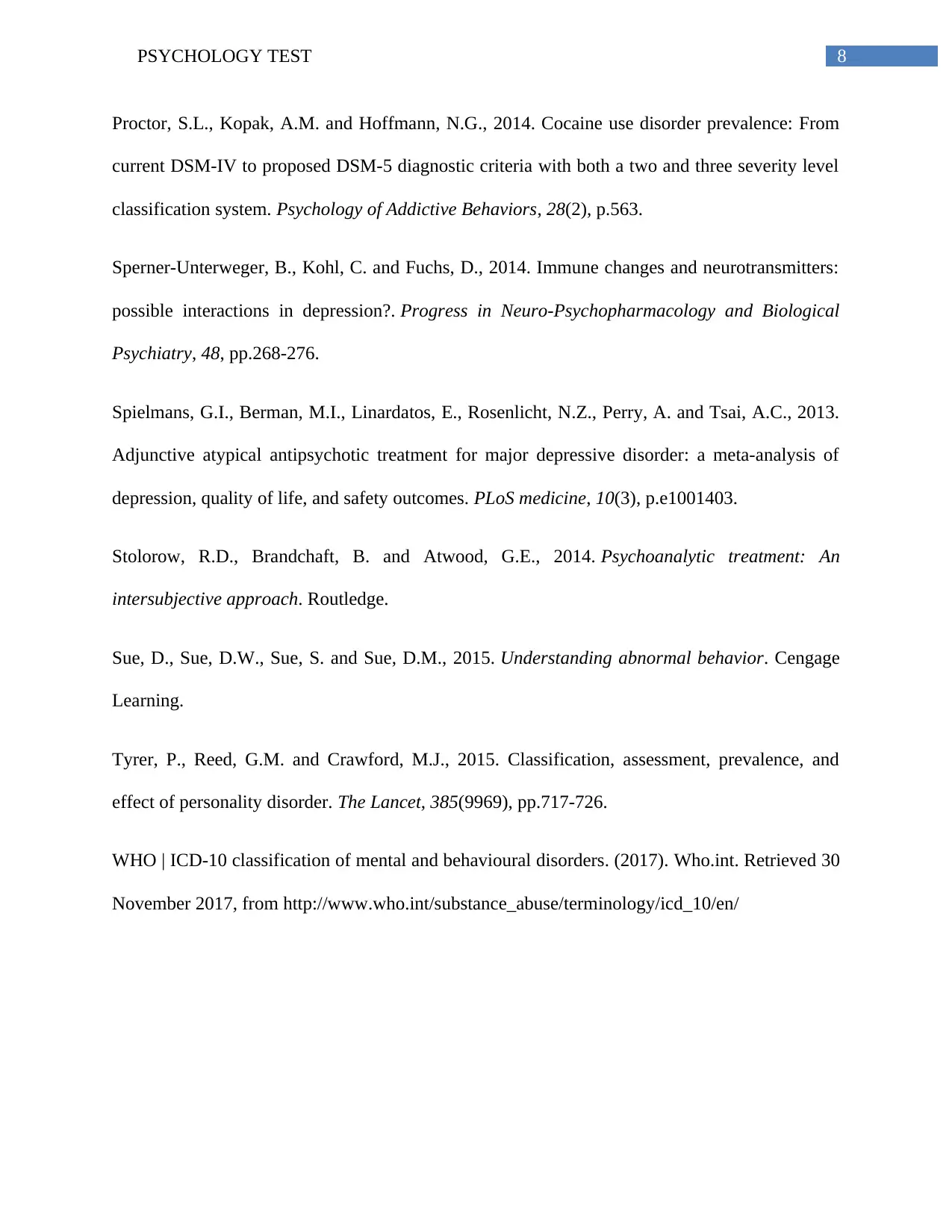
8PSYCHOLOGY TEST
Proctor, S.L., Kopak, A.M. and Hoffmann, N.G., 2014. Cocaine use disorder prevalence: From
current DSM-IV to proposed DSM-5 diagnostic criteria with both a two and three severity level
classification system. Psychology of Addictive Behaviors, 28(2), p.563.
Sperner-Unterweger, B., Kohl, C. and Fuchs, D., 2014. Immune changes and neurotransmitters:
possible interactions in depression?. Progress in Neuro-Psychopharmacology and Biological
Psychiatry, 48, pp.268-276.
Spielmans, G.I., Berman, M.I., Linardatos, E., Rosenlicht, N.Z., Perry, A. and Tsai, A.C., 2013.
Adjunctive atypical antipsychotic treatment for major depressive disorder: a meta-analysis of
depression, quality of life, and safety outcomes. PLoS medicine, 10(3), p.e1001403.
Stolorow, R.D., Brandchaft, B. and Atwood, G.E., 2014. Psychoanalytic treatment: An
intersubjective approach. Routledge.
Sue, D., Sue, D.W., Sue, S. and Sue, D.M., 2015. Understanding abnormal behavior. Cengage
Learning.
Tyrer, P., Reed, G.M. and Crawford, M.J., 2015. Classification, assessment, prevalence, and
effect of personality disorder. The Lancet, 385(9969), pp.717-726.
WHO | ICD-10 classification of mental and behavioural disorders. (2017). Who.int. Retrieved 30
November 2017, from http://www.who.int/substance_abuse/terminology/icd_10/en/
Proctor, S.L., Kopak, A.M. and Hoffmann, N.G., 2014. Cocaine use disorder prevalence: From
current DSM-IV to proposed DSM-5 diagnostic criteria with both a two and three severity level
classification system. Psychology of Addictive Behaviors, 28(2), p.563.
Sperner-Unterweger, B., Kohl, C. and Fuchs, D., 2014. Immune changes and neurotransmitters:
possible interactions in depression?. Progress in Neuro-Psychopharmacology and Biological
Psychiatry, 48, pp.268-276.
Spielmans, G.I., Berman, M.I., Linardatos, E., Rosenlicht, N.Z., Perry, A. and Tsai, A.C., 2013.
Adjunctive atypical antipsychotic treatment for major depressive disorder: a meta-analysis of
depression, quality of life, and safety outcomes. PLoS medicine, 10(3), p.e1001403.
Stolorow, R.D., Brandchaft, B. and Atwood, G.E., 2014. Psychoanalytic treatment: An
intersubjective approach. Routledge.
Sue, D., Sue, D.W., Sue, S. and Sue, D.M., 2015. Understanding abnormal behavior. Cengage
Learning.
Tyrer, P., Reed, G.M. and Crawford, M.J., 2015. Classification, assessment, prevalence, and
effect of personality disorder. The Lancet, 385(9969), pp.717-726.
WHO | ICD-10 classification of mental and behavioural disorders. (2017). Who.int. Retrieved 30
November 2017, from http://www.who.int/substance_abuse/terminology/icd_10/en/
1 out of 9
Related Documents
Your All-in-One AI-Powered Toolkit for Academic Success.
+13062052269
info@desklib.com
Available 24*7 on WhatsApp / Email
![[object Object]](/_next/static/media/star-bottom.7253800d.svg)
Unlock your academic potential
© 2024 | Zucol Services PVT LTD | All rights reserved.





